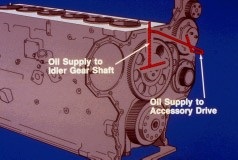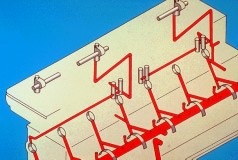
The lubrication system contains the following components:
- Oil pick-up tube and suction bell
- Oil pump
- Oil pressure relief valve
- Oil cooler bypass valve
- Oil cooler
- Oil filter bypass valve
- Oil filter
- Oil supply to turbocharger
- Oil supply to engine

Oil Passages
The lubrication system inside the engine includes the following components:
- Oil manifold (gallery) in block
- Piston cooling jet
- Oil passage to main and cam bearings
- Camshaft and main bearing oil passage
- Front oil supply for lifters
- Rear oil supply for lifters
- Front oil supply to rocker shaft
- Rear oil supply to rocker shaft
- Oil supply to fuel pump

Front Gear Train Lubrication
The lubrication for the front gear train includes the:
- Oil supply to idler gear shaft
- Oil supply to accessory drive
Let’s trace the flow of oil through each component.

Oil Pump Oil Flow
Lubricating system flow begins as the pump draws oil from the oil pan sump. The oil pump pick up tube has a suction bell at the open end which is located low in the pan sump. The suction bell contains a screen to prevent foreign material from entering the oil pump.
Many Caterpillar engines are designed to work in applications that may require the engine be at a steep angle. A track type tractor for example, typically is used in applications that require the machine and engine be at a relatively steep angle from the horizontal. In order to ensure that all of the engine oil does not collect in one end of the oil pan, away from the suction bell, many engines also have a scavenge oil pump. A scavenge oil pump is nothing more than an oil pump that ensures that there is always oil in the main sump. This keeps the lubrication system from being starved of oil at steep slopes.

Oil Pump Description
The oil pump is a positive displacement gear type pump, driven by the crankshaft gear.

The basic gear pump is the type most commonly found on Caterpillar engines. This pump has two gears in mesh. One gear is driven by the engine and the other is an idler gear. The two gears rotate in opposite directions capturing the engine oil, and drawing it around the inside of the housing. When the teeth come together in mesh the oil is forced out of the teeth and flows through the pump outlet to the rest of the lubrication system.

Some Perkins engines use a rotor type pump. This pump has an inner gear and a outer gear that are in mesh with one another. The inner gear is driven by the engine. The center line of the outer gear is offset from the inner gear and is free to turn. As the inner gear is turned it causes the outer gear to rotate. Engine oil is drawn into the pump through the inlet and carried in the space between the two rotating parts to the outlet. On the outlet side the inner gear and the outer gear come into mesh with one another and force the oil to be pushed out the outlet port of the pump.

Oil Pump Relief Valve
The oil pump has an integral pressure relief valve which controls the maximum system operating pressure. Limiting the pressure helps to reduce leaks and prolong seal life.

Oil Pump Relief Valve
The valve will remain on its seat (closed) until the oil pressure at the pump rises above the pressure that is exerted by the spring in the valve.
As pressure in the system nears the maximum, it will force the valve off its seat and allow some oil to bypass to the low pressure side of the pump. If the pressure in the system continues to rise, the valve plunger will move farther down allowing more flow to bypass.
When the engine oil is cold it will be thick or have a high viscosity, and will resist flowing. During cold engine start ups the oil will resist flowing through the engine. Pressure will build quickly, causing the valve to open.

Oil Cooler
Many engines are equipped with an oil cooler assembly. The cooler utilizes an engine oil to coolant heat exchanger. Hot engine oil passing through the cooler element transfers heat to the engine coolant. This cooling of the oil helps to maintain the lubricating properties of the oil under heavy engine load.

Oil Cooler Bypass Valve
During cold start up, the cold oil will also resist flowing through the oil cooler. To prevent this resistance from causing oil starvation, an oil cooler bypass valve is incorporated into the cooler assembly. This bypass valve senses oil pressure between the inlet and outlet of the cooler. It is designed to open and bypass oil flow around the cooler when the oil is cold and thick.

Oil Filter
The oil filter base mounts at least one filter element. Most Caterpillar engines use spin-on style full flow filters in order to remove damaging foreign materials from the engine oil.

Oil Filter Bypass Valve
The engine oil flows in the outside of the filter, through the filter media, and out the hole in the center of the filter under normal operating conditions. However, the filter element resists cold oil flow. It also resists oil flow when it becomes dirty. To prevent damage to the element and possible oil starvation to the system, the filter base is equipped with a filter bypass valve. The bypass valve senses the pressure differential across the element and will open, bypassing oil flow around the element if the pressure becomes excessive. This is one reason why proper maintenance procedures are so important. Dirty filters can lead to serious problems.

Turbocharger Lubrication
The turbocharger oil supply line is connected to the outlet of the filter base. An adequate supply of cooled, clean oil is essential to turbocharger life. Thus, the turbocharger receives oil flow before other engine components. Oil cools, and lubricates the bearings of the turbocharger. Oil flow from the turbocharger is returned to the oil pan. This is also why hot shutdowns or high rpm shutdowns of the engine are bad. Insufficient oil flow under these conditions could lead to premature failure of the turbocharger. The turbocharger needs the oil to cool and to lubricate its bearings.

Piston Cooling Jets
Clean, cooled oil is directed from the filter base to the oil manifold in the engine block. The piston cooling jets are connected to the oil manifold and direct a small stream of oil to the underneath side of the pistons for cooling. This helps to cool the pistons to a uniform temperature and provide a longer service life of the pistons.

Oil Supply to Bearings
Each pair of main and camshaft bearings is connected by an oil passage that is drilled in the block. The drilled passage receives oil through an intersecting drilled passage that is connected to the oil manifold.

Oil Supply to Crankshaft Bearings
A groove around the inside of the upper main bearing shells supplies oil flow to internal drilled passages in the crankshaft. The internal crankshaft passages supply oil to the connecting rod bearings.

Valve Lifter Lubrication
A groove around the outside of the front and rear camshaft bearings supply oil flow to the front and the rear valve lifter passages. Each lifter body, roller and lower push rod socket receive lubrication from these passages.

Rocker Shaft Lubrication
The rear rocker shaft receives oil flow from the rear valve lifter oil passage. The front rocker shaft receives oil flow from a drilled passage connected to the front camshaft supply passage.
Drilled passages in the rocker shafts supply the upper valve train with oil flow. This is also used to supply oil to the compression release brake (Jake BrakeÒ), if equipped.

Front Gear Train Lubrication
The front gear train idler gear and the accessory drive receive oil flow from an internal drilled passage that is connected to the front camshaft oil passage.

Air Compressor Lubrication
The air compressor receives oil from the oil passage to the accessory drive, through passages in the timing gear housing and the accessory drive gear.

Fuel System Lubrication
In a typical Caterpillar pump and line fuel system the fuel pump, governor and hydraulic timing advance unit receive oil flow from a port on the side of the block. This port is connected to the number three main and camshaft passage.

BrakeSaver Option
Since the BrakeSaver retarder option becomes an integral part of the lubrication system, we will review the operation of the BrakeSaver along with the changes to the lubrication system the option requires.
As we learned earlier, the BrakeSaver retarder is a hydraulic retarder that provides smooth, efficient vehicle breaking on long downhill grades.

Brake Saver Oil Pump
Engines equipped with a BrakeSaver retarder have a two section oil pump. The front section of the pump supplies oil for the lubrication of the engine. The path of the oil from the front section is the same as the standard oil pump, except the oil does not go to the oil cooler. The oil from the front section of the pump flows directly to the oil filter.
The rear section of the oil pump supplies oil for BrakeSaver operation and oil cooling.

Oil Pump Bypass Valve
When the oil is cold, the high viscosity causes the bypass valve to open and drain the oil from the rear section of the pump back into the oil pan.